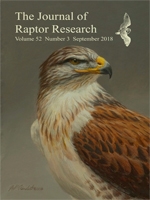Roost sites are likely an important component of the American Kestrel's (Falco sparverius), kestrel(s) hereafter, nonbreeding habitat, as quality roost structures can provide thermal cover and protection from predators. We studied winter roost-site use by kestrels in an agricultural landscape in South Texas, where the population is composed of a combination of territorial wintering birds and migrating individuals passing through. Through observations of color-marked and unmarked birds, we identified 50 roost sites during September–March, 2014–2017. Kestrels utilized foliated shrubs and trees as roosting sites (n = 24), as well as various human-made structures (n = 26) including buildings, petroleum and farm equipment, and electrical structures for roost sites. Roost sites varied greatly in the level of concealment and exposure, with seven kestrels roosting on electric structures that allowed high levels of exposure to weather and potential avian predators. We observed aggression between kestrels around roost sites, and we documented small communal kestrel roosts. Because we observed roosting in sites exposed to weather and predators, aggression around roost sites, and communal roosting, we speculate that roosting sites suitable for kestrels may be limited or poorly dispersed in this agricultural landscape.
How to translate text using browser tools
1 September 2018
American Kestrel Nonbreeding Roost Use and Behavior in South Texas
Carter G. Crouch
ACCESS THE FULL ARTICLE

Journal of Raptor Research
Vol. 52 • No. 3
September 2018
Vol. 52 • No. 3
September 2018
American kestrel
communal roost
Falco sparverius
roost
roost site use




